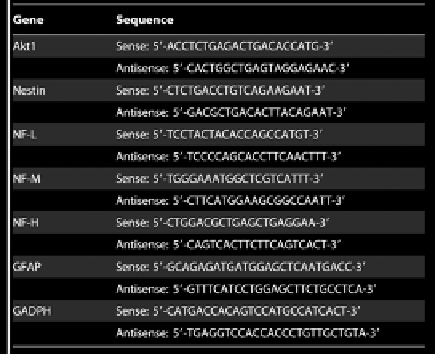Biology Reference
In-Depth Information
cultures. Stably transfected colonies were selected by neomycine resistance. Several
stable clones of human NSCs (hNSCs) were isolated, and one of them, HB1.F3
(F3 hereafter), was expanded for the present study. F3 hNSCs express ABCG2,
nestin and Musashi1, which are cell type specific markers for NSCs [15], [34].
To generate Akt1 overexpressing hNSC line (F3.Akt1), Akt1 cDNA
(Upstate, Charlottesville, VA) was ligated into multiple cloning sites of the
retroviral vector pLHCX (Clontech, Mountain View, CA). Before the li-
gation, mouse Akt1 cDNA was PCR-amplified by using forward primer 5
′
-
CTAGTTAAGCTTATGGGGAGCAGC-3
′
; reverse primer 5
′
- GATATGATC-
GATTGATC AGAGGGTTTA -3
′
. PA317 amphotropic packaging cell line was
infected with the recombinant retroviral vector, and the supernatants from the
packaging cells were added to the F3 hNSCs. Stably transfected colonies were
selected by hygromycin resistance.
rt-Pcr Analysis
Reverse transcription was performed with M-MLV reverse transcriptase (Promega,
Madison, WI) for 1 hr at 42°C, inactivated for 15 min at 95°C and cooled at 4°C.
PCR reaction solution consisted of DNA polymerase buffer, containing cDNA 1
µL, 5 mM MgCl
2
, 1 mM dNTPs, 10 pM primers and 2.5 units Taq polymerase
(Promega). The cDNA was amplified using 30 PCR cycles and RT-PCR products
were separated electrophoretically on 1.2% agarose gel containing ethidium bro-
mide and visualized under UV light. The primers used for the RT-PCR for nes-
tin, neurofilament (NF)-L, NF-M, NF-H, glial fibrillary acidic protein (GFAP),
GAPDH and Akt1 are listed in Table 1.
Table 1.
PCR primer sequences for cell type-specific markers (all human).


Search WWH ::

Custom Search